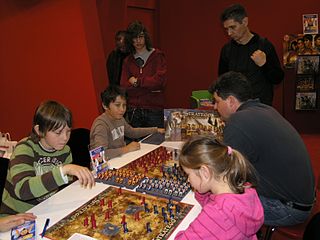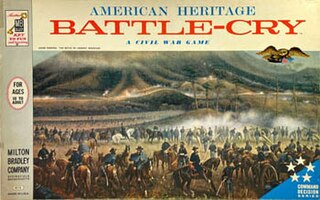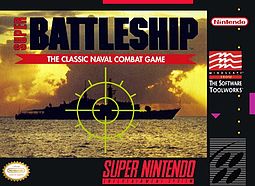
Stratego is a strategy board game for two players on a board of 10×10 squares. Each player controls 40 pieces representing individual officer and soldier ranks in an army. The pieces have Napoleonic insignia. The objective of the game is to either find and capture the opponent's Flag or to capture so many enemy pieces that the opponent cannot make any further moves. Stratego has simple enough rules for young children to play but a depth of strategy that is also appealing to adults.

A torpedo boat is a relatively small and fast naval ship designed to carry torpedoes into battle. The first designs were steam-powered craft dedicated to ramming enemy ships with explosive spar torpedoes. Later evolutions launched variants of self-propelled Whitehead torpedoes.

Scotland Yard is a board game in which a team of players controlling different detectives cooperate to track down a player controlling a criminal as they move around a board representing the streets of London. It was first published in 1983. It is named after Scotland Yard which is the headquarters of London's Metropolitan Police Service in real-life. Scotland Yard is an asymmetric board game, during which the detective players cooperatively solve a variant of the pursuit–evasion problem. The game is published by Ravensburger in most of Europe and Canada and by Milton Bradley in the United States. It received the Spiel des Jahres award in 1983-the same year that it was published.

Twister is a game of physical skill produced by Milton Bradley Company and Winning Moves Games USA. It is played on a large plastic mat that is spread on the floor or ground. The mat has four rows of six large colored circles on it with a different color in each row: red, yellow, green and blue. A spinner tells players where they have to place their hand or foot. The game promotes itself as "the game that ties you up in knots".

Trouble is a board game in which players compete to be the first to send four pieces all the way around a board. It is based on a traditional game called "Frustration" played on a wooden board with indentations for marble playing pieces and rules similar to Parcheesi. Pieces are moved according to the roll of a die using a contained device called a "Pop-O-Matic".

Battleship is a strategy type guessing game for two players. It is played on ruled grids on which each player's fleet of warships are marked. The locations of the fleets are concealed from the other player. Players alternate turns calling "shots" at the other player's ships, and the objective of the game is to destroy the opposing player's fleet.
Battlefleet Gothic is a naval miniature wargame that was produced by Games Workshop from 1999 to 2013 with Andy Chambers as the primary developer. A spin-off of the science-fantasy setting of Warhammer 40,000, the game has players command fleets of large spaceships belonging to one of several spaceborne factions. Although the wargame's miniatures and rulebooks are no longer supported by Games Workshop, two video game adaptations have been made since its cancellation in 2013.

Broadsides and Boarding Parties is a board game published by Milton Bradley in 1984 as part of their Gamemaster series. It was the 3rd in the series of games that are all designed by Larry Harris. It is the only game of that series to feature a two player game, Broadsides and Boarding Parties is a duel between a Spanish galleon and a pirate ship. Players take turns moving their ship and firing at the other ship to sink her. If the ships collide then players may take boarding parties onto the other ship to try to win.

Shogun is a board wargame set in feudal Japan, first released in 1986 by game maker Milton Bradley.

Space Crusade is an adventure board game produced by Milton Bradley together with Games Workshop and was first made in 1990. It was produced in the UK and available in some other countries including Finland, Ireland, France, Spain, Denmark, Australia, Hellas and New Zealand. In Germany, Italy, Belgium and the Netherlands, it is known as Star Quest.
Axis & Allies: Pacific is a strategy board game produced by Hasbro under the Avalon Hill name brand. Released on July 31, 2001 and designed by Larry Harris, the designer of the original Axis & Allies game, Axis & Allies: Pacific allows its players to recreate the Pacific Theater of World War II.

Perfection is a game originally produced by the Pennsylvania company Reed Toys and then by the Milton Bradley company. The object is to put all the pieces into matching holes on the board before the time limit runs out. When time runs out, the board springs up, causing many, if not all, of the pieces to fly out. In the most common version, there are 25 pieces to be placed into a 5×5 grid within 60 seconds.

Battle-Cry is a combat board game set in the American Civil War that was published by the Milton Bradley Company in 1961 as part of their popular American Heritage series.

Mall Madness is a shopping themed board game released by Milton Bradley in 1988.

Super Battleship is a naval simulator video game released for the Genesis and Super NES in 1993. The game is strictly single-player and is primarily a strategy game with some real-time elements. It is based on the Battleship board game by the Milton Bradley Company.

Victory at Sea, subtitled "World War II Naval Combat Game", is a set of World War II naval wargaming rules published by Mongoose Publishing in 2006.
Space Fleet is a board game for 2-4 players, published in 1991 by Games Workshop and designed by Jervis Johnson and Andy Jones.

Thunder Road is a post-apocalyptic themed racing board game invented by Jim Keifer and published by Milton Bradley. Using an assortment of four different vehicles each ranging from a modified dune buggy to a gyrocopter, players must race down an infinite roadway against one another. The goal of the game for players is to either be the last player team alive or simply out race the other teams. Although the game was originally published by Milton Bradley in 1986, Hasbro currently owns the rights to the game, since it acquired Milton Bradley in 1984.

Z17 Diether von Roeder was one of six Type 1936 destroyers built for the Kriegsmarine in the late 1930s. Completed in 1938, the ship spent most of her time training although she did participate in the occupation of Memel in early 1939. At the beginning of World War II in September, the ship was initially deployed to lay minefields off the German coast, but was soon transferred to the Skagerrak where she inspected neutral shipping for contraband goods. In late 1939, the ship helped lay an offensive minefield off the English coast that claimed seven merchant ships.

















